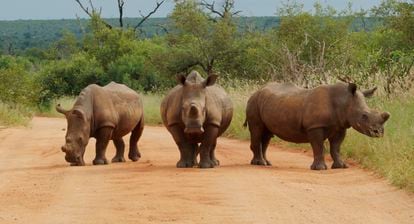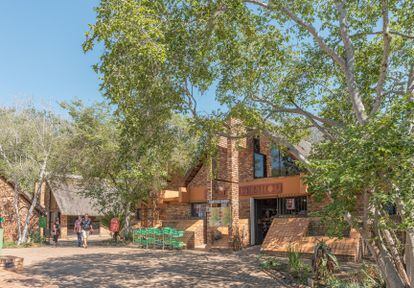It's half past four in the morning, still dark at night. A ranger sleepily opens the access door to the Berg-en-Dal camp and the beams of light from the only two SUVs waiting for the moment break the blackness of the savannah like milky swords. None of them are my vehicle. I know that to see animals you have to get up early, but not that early. I leave an hour later, just as the sun begins to rise over the horizon of thorny acacias, marulas and climbing willows of the Kruger National Park, the largest and most famous in South Africa. A new day dawns in this large South African reserve the size of the province of Cáceres, whose fauna exists thanks to a conservationist politician, Paul Kruger, president of the Republic of Transvaal, who already in 1898 decided that something should be done against poaching and indiscriminate hunting or all the animals in the country would disappear.
For two days I have been traveling through this enormous reserve, today converted into an icon of nature conservation and a gigantic tourist resource for Nelson Mandela's country. And like the other two times I visited, it is not disappointing. The Kruger It is reputed to be the best place in Africa to see the so-called Big Five (lion, leopard, buffalo, rhinoceros and elephant), and at the moment I have written down four, I am only missing the elusive leopard. Unlike those other two occasions (one of them in 2010, when South Africa experienced the madness of the Soccer World Cup that Spain won and the country sounded like vuvuzela), I am traveling now in January, in the middle of the southern summer, and the landscape is emphatically more beautiful than on my other winter or autumn visits. It is true that all the safari traveler's manuals say that the dry season is better to see animals, because the undergrowth is clear of forest and the animals cannot hide behind it and because the scarce water reserves are concentrated in certain pools, where it is easy to stand at dusk to see all kinds of bugs while they drink. All this is true; In summer the forest is completely green, the animals get lost in the thicket and, if they are not close to the road, it is more difficult to see them. But in return, the spectacular nature of the diverse ecosystems that make up the Kruger, from the wooded savanna in the south to the herbaceous grasslands in the north, is captivating. A thousand shades of green dot the park's hills, which undulate like gentle waves, dotted here and there by enormous granite kopjes that emerge from time to time, like ruined fortresses. The landscape more than compensates for the fact that, from time to time, a kudu or an elephant escapes behind a screen of mopanes.
Anyway, Krugers seem to like man-made roads. The day I entered I did so in the late afternoon through the Malelane gate, from where a 15 kilometer paved road leads to the Berg-en-Dal camp. Well, shortly before reaching the camp, a pride of lions made up of an adult and dominant male, another young male and five lionesses were dozing lying in the middle of the road – as they do all day -, impassive and as if with them. It wasn't the traffic jam that had formed. It wasn't that two dozen cars were harassing a stunned lion, as we have seen in images from other parks. The thing is that the road was literally blocked by the herd and they couldn't go in one direction or another until they decided to move. It was a really beautiful spectacle. Enjoying those wonderful animals just a foot from your window, lying down and indolent, oblivious to everything, is something that doesn't happen every day. Of course, those of us who were going to the camp were wondering if this situation would serve as an excuse for arriving late, because in these official Kruger camping places the doors close at 6:30 p.m. and no one can be outside the limited and protected places, under penalty of a heavy fine. Would the traffic jam produced by lions be an excuse?
The next day, three huge rhinos had also decided to spend some time in the middle of the track on which I was heading towards Skukuza and they gave me another unforgettable moment. This is the Kruger National Park, which with its 370 kilometers long and about 66 wide, covers almost two million hectares. Personally, I would rank it among the six best parks in Africa to see local wildlife. It is not as wild as Etosha, in Namibia, or Chobe, in Botswana. In fact, it is surrounded by civilization and urban life, so much so that the scene with the lions that I have narrated occurred just eight kilometers in a straight line from the McDonald's and the gas station on the Malelane industrial estate). It also does not have as many lions as the Serengeti (Tanzania), but its average density of all types of animals is much higher than that of almost any other large park on the African continent. That's why he is so famous. And busy.
Bulletin
The best travel recommendations, every week in your inbox
RECEIVE THEM
The embryo of the park was Sabie Game Reserve which President Kruger promoted in 1898, when the current South Africa did not yet exist as a country, so that “animals can be protected and nature can continue to be intact as the Creator made it,” in his own words. At that time, the fur and ivory trade was a lucrative business. In 1902, James Stephenson-Hamilton, a soldier of Scottish origin, became the reserve's first warden and went down in history for his dedication to the conservation cause (he held the position for 44 years) and his successful campaign against poaching. So much so that the Tsonga who lived in those lands nicknamed him skukuza, “the one who turns everything upside down.” The Sabie reserve and other neighboring reserves became a national park named after their creator on May 31, 1926, when the South African Parliament declared the National Park Act. In 1927 it opened its doors to the public.

Another aspect that also makes it appealing is that this is one of the few African national parks that you can visit on your own. The easiest thing is to fly to Johannesburg, the closest international airport with the best connectivity to Europe, rent a car there and in about four and a half hours of excellent road you get to either of the two southern gates: Malelane or Numbi. As long as you don't drive at night, moving alone on this route is completely safe. At the chosen gate you do the entry procedures, pay the fee (about 25 euros per day) and that's it: you can move freely around the park. There are two types of roads, paved roads and dirt roads. In the former, the maximum speed is 50 kilometers per hour and in the latter, 40. More speed entails a danger for the animals that are going to cross you on the road, no matter what, and even for you, because crashing against an elephant or a rhinoceros is like doing it against a stone wall. Furthermore, it is absurd to go faster because the point is to look for animals, not to get anywhere.
You can only spend the night in one of the 23 official campsites. In all of them there are bungalows of various types and prices and camping areas. And in the 12 main ones, there is also a souvenir and food store, information, swimming pool, restaurant, gas station, viewpoint, pond to see animals and a metal board where each person marks with small magnetic tokens the places where they have seen large animals to Help other travelers. It is essential to buy as soon as you arrive the official park map to be able to move through that maze of roads and dirt tracks.
Scattered throughout the park are picnic areas with bathrooms (marked P on the map), which are the only ones where you can get out of the car. My advice is to book accommodation in advance at the camp you want through the official website of south african parks. In it you can also hire game drives in the park's open vehicles accompanied by a rangerwho will always know best where the large mammals are and where to stand to see them, you, humble urbanite.

And what is the best season to visit Kruger? In reality, you can visit all year round, but it is better to avoid June and July, deep winter, when it is very cold and the animals are more lethargic. Summer, from December to February, is hotter, with maximum temperatures that can reach 35ºC; The landscape is green and spectacular, but that makes it impossible to locate the animals in the distance. Spring, which runs from September 1 to November 30, or autumn, from March 1 to May 31, are the perfect seasons of temperature and visibility for a safari.
As for the time needed, it depends on your interest in wildlife. I would say at least three days and two nights to see something. One piece of advice is that you don't try to travel long distances, just by doing more kilometers you won't see more animals. It is better to plan where the ponds are and take advantage of the sunrises and sunsets to move through some specific areas around the chosen camp. A classic route, which never fails for a short stay, is the one that links the camps of Skukuza, Berg-en-Dal, Crocodile Bridge and Lower Sabie, all in the southern sector. With that and with a little luck and good eyesight, you will surely score the Big Five and the thousand medium and small ones who live in this kind of Noah's ark that was miraculously preserved on the border between South Africa and Mozambique.
Subscribe here to The Traveler newsletter and find inspiration for your next trips in our accounts Facebook, x and instagram.
#visit #Kruger #National #Park #book #camp #advance #safari #ranger